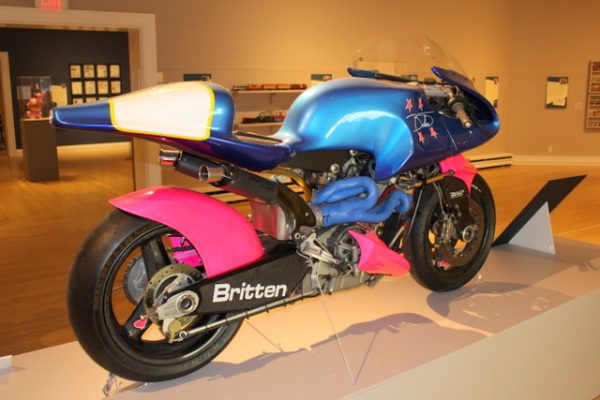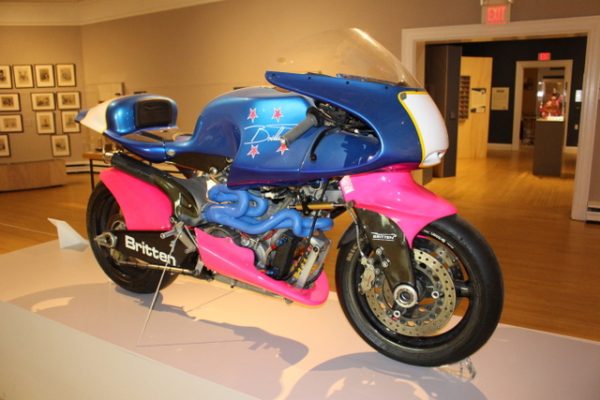It stands upright on a podium, secured from beneath by thin cables and bookended to the front and rear by two other uncommon motorcycles that are posed on platforms that are appropriately lower. Spotlights in  the ceiling make its bright blue and pink paint sparkle. The race-bike rarity is so exquisite that it warrants display in a museum. It has been shown off in the past – in the Guggenheim Museum’s “Art of the Motorcycle” exhibition in 1998. It is being showcased again for a limited time in the “Berkshire Collects” exhibit which runs through May 11 at the Berkshire Museum in Pittsfield, Mass.
the ceiling make its bright blue and pink paint sparkle. The race-bike rarity is so exquisite that it warrants display in a museum. It has been shown off in the past – in the Guggenheim Museum’s “Art of the Motorcycle” exhibition in 1998. It is being showcased again for a limited time in the “Berkshire Collects” exhibit which runs through May 11 at the Berkshire Museum in Pittsfield, Mass.
Motorcycle aficionados will immediately recognize the name that’s scripted on the gas tank and plastered on other parts – Brit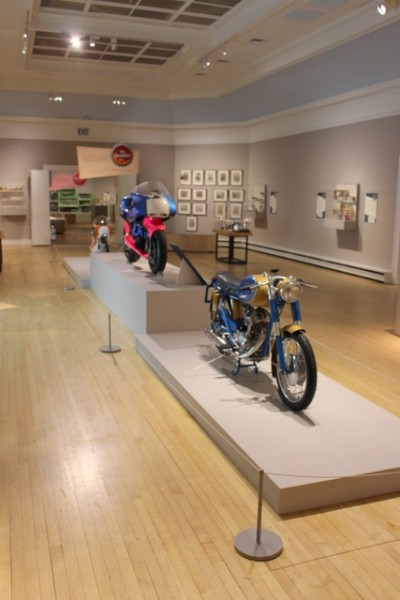 ten.
ten.
For them, and for anyone with an appreciation of motorcycles as pieces of art, the exhibit offers what’s most likely a once in a lifetime opportunity to see a Britten. This one’s on loan from its owner, Jim Hunter of Williamstown, Mass. He also owns the other two bikes on display, an Italian-made Ducati and a German-made Kreidler.
The short-lived Britten motorcycles came from Christchurch, New Zealand, handcrafted by visionary builder named John Britten, who used composite materials and imaginative designs to make revolutionary machines. The Britten V1000 had success against factory race bikes from Ducati, Harley-Davidson and Honda in the “Battle of the Twins” races at Daytona in the early 1990s, with Hunter’s Britten winning the race in 1994. Only 10 were ever built as Britten died from cancer in 1995 at age 45.
Britten and Hunter were friends, and that’s how Hunter came into possession of one. “John Britten was a pretty amazing guy. He designed that entire bike himself. He was very interesting guy. Sort of a free spirit, you’d say, as a young man. He was a very creative guy with a lot imagination,” said Hunter, explaining that Britten even made the molds for the motor castings “in a workshop about the size of a one-car garage.”
The Britten motorcycle was a bike ahead of its time. “Every part that’s not metal on the bike is carbon fiber. There is no frame on the bike. Everything just bolts to the motor. The suspension is a really unique setup. There are on-board electronics on the bikes that were probably a decade or so ahead of the stuff the Moto GP guys use,” Hunter said.
If you look for front forks where the front wheel is normally mounted, you won’t 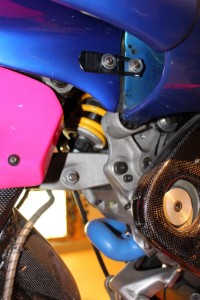 see them. The Britten doesn’t have forks. If you look for rear shocks, you won’t see them, either. There are two springs attached to the top and bottom of the motor in front. If you look for a radiator behind where the forks should be, you won’t see it as well as it’s under the seat.
see them. The Britten doesn’t have forks. If you look for rear shocks, you won’t see them, either. There are two springs attached to the top and bottom of the motor in front. If you look for a radiator behind where the forks should be, you won’t see it as well as it’s under the seat.
“You don’t have this great big barn door up in front,” said Hunter, referring to the usual spot for the radiator. “The bike can be a lot slimmer, a lot more aerodynamic.” The reduction of drag makes Britten “a little bit faster.”
With 165 horsepower and a weight of 341 pounds when fully fueled, the Britten practically flew. “I was told my bike held the top speed for motorcycles at Daytona for 10 years,” reaching “somewhere north of 185” miles per hour on the back straight, Hunter said. At the time, the Britten had a lot of things that technically set it apart,” he said, allowing that 20 years later “technology today has caught up with them.”
Hunter used to race himself and sponsored race teams. That’s how he met Britten. They pitted together at Daytona. “We got to be very good friends. There had been rumor going around at that time that he was considering building streets bikes,” said Hunter, recalling that he told Britten that he’d be interested in buying one. He got a race bike instead. “A couple of months later he called me about two o’clock in the morning my time. Being asleep in the middle of the night, it seemed like a great idea,” he said.
It was only a year and a half later that Britten died. “He was genius, an amazing guy and he died way too young,” said Hunter, who attended the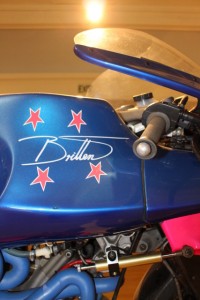 funeral in New Zealand. “The guy’s a national hero in New Zealand, even today.”
funeral in New Zealand. “The guy’s a national hero in New Zealand, even today.”
The 10 Brittens that were built are now scattered around the globe and are now mostly owned by collectors. As can best be determined, there are three in New Zealand, one in South Africa and one in Italy. There are five in U.S. Private collectors in Michgan, Texas and California own three and the Barber Vintage Motorsports Museum in Birmingham, Ala. has the fourth.
Hunter keeps his Britten in his home office. To him, it’s irreplaceable because of his friendship with Britten and the 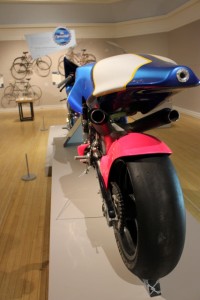 fact he was hand-picked to buy one. “You can’t put a dollar value on that. If someone walked into the house and said, ‘I’ll give you a million dollars for that bike,’ I’d probably say ‘No.’ I don’t know what I’ll ever do with it. It sits in my office so I get to look at it every day.” – By Bud Wilkinson
fact he was hand-picked to buy one. “You can’t put a dollar value on that. If someone walked into the house and said, ‘I’ll give you a million dollars for that bike,’ I’d probably say ‘No.’ I don’t know what I’ll ever do with it. It sits in my office so I get to look at it every day.” – By Bud Wilkinson
(Originally published in “The Republican-American” on April 12, 2014)
Below is a short video of the Britten on display at the Berkshire Museum.
 Ride CT & Ride New England Serving New England, NYC and The Hudson Valley!
Ride CT & Ride New England Serving New England, NYC and The Hudson Valley!

